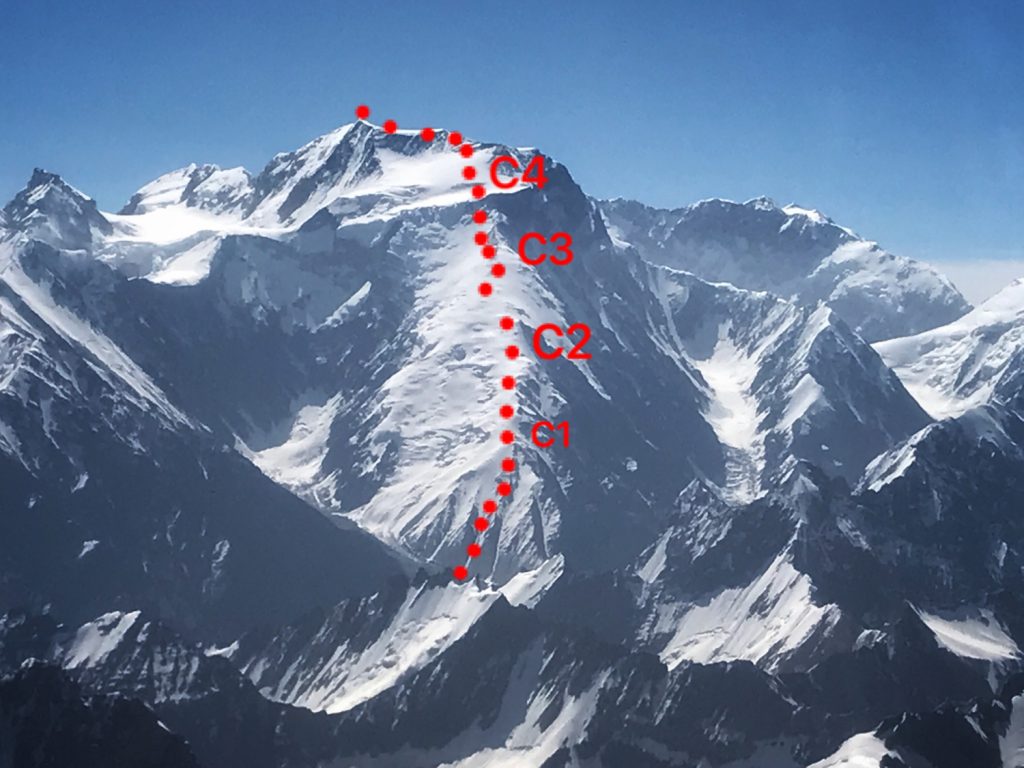An Afghan Woman’s Ascent of Noshaq: A Conversation with Emilie Drinkwater
Angela Hawse: You’ve recently returned from Afghanistan where you were instrumental in the success of the first Afghan woman’s ascent of the country’s highest peak. I know you’ve been involved in training these women for several years since their beginnings. This story is phenomenal and that you were able to go from teaching them how to climb to ascending a 24,580’ tall peak within three years is remarkable. Noshaq peak, in the Hindu Kush range is just under 7500m with only 2 or 3 other ascents by Afghan men. That you took a group of young women to this remote mountain in this Taliban occupied zone is just heroic. Can you tell us a little bit about Ascend: Leadership through Athletics and your involvement in their work?
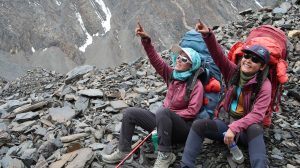 Emilie Drinkwater: Ascend is an American NGO based in Kabul, Afghanistan working with young, Afghan women to develop leadership skills through mountain climbing. Though I worked with this organization in 2015 to help train and guide a group of Afghan women on several first ascents in the Panjshir Valley (just north and east of Kabul), my contribution, other than that, has actually been minimal.
Emilie Drinkwater: Ascend is an American NGO based in Kabul, Afghanistan working with young, Afghan women to develop leadership skills through mountain climbing. Though I worked with this organization in 2015 to help train and guide a group of Afghan women on several first ascents in the Panjshir Valley (just north and east of Kabul), my contribution, other than that, has actually been minimal.
For this recent trip to the Wakhan Corridor I was actually hired by a small crew of filmakers looking to document the attempt of these Afghan women to climb the country’s highest peak (Mt Noshaq). A very unexpected turn of events the week before the trip started resulted in me becoming the expedition leader after Danika Gilbert (who would have just guided the Afghan girls — also, they’re referred to as girls since they are unmarried), left the expedition on short notice. The only way for the trip to possibly move forward was for me to take on the roll of guide for both the film crew and the Afghan girls (I did have an assistant — a Norwegian woman with quite a bit of 8000m experience but not a guide).
I certainly never sought to take on this much work or responsibility as both the Afghan girls and the film crew were incredibly inexperienced climbers. Also, 7500m is a strangely dangerous elevation since it’s very high but not quite high enough to use oxygen. Lastly, Noshaq is very remote and other than porters to basecamp, the climbing was unsupported both physically and logistically. Though apprehensive to take on so much, I figured that in an organization looking to teach leadership, I should step up and try to demonstrate that in the best way that I could. I also really wanted to see an attempt made since everything else was in place and we’d been planning this trip for 8 months (By we: I mean the film crew and I; Ascend has been planning and training for this expedition since their inception). That said, there were no odds stacked in our favor and I never expected that we’d actually get an Afghan to the summit! There are layers upon layers of complexity to a women’s climbing expedition in Afghanistan and if nothing else, I learned to look at risk and hazard in a whole new way.
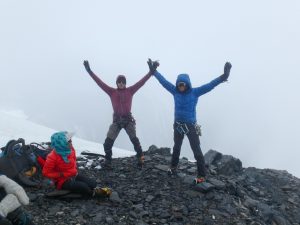 Angela: Can you paint a picture of just how radical it is in Afghanistan for women to not only accomplish but to attempt to climb the highest mountain?
Angela: Can you paint a picture of just how radical it is in Afghanistan for women to not only accomplish but to attempt to climb the highest mountain?
Emilie: Afghanistan is routinely ranked as the world’s worst place to be a woman, let alone a woman who wants to participate in sports. While not exactly illegal under Islamic or Sharia Law, it is considered dishonorable for women to do much of anything athletic (including riding a bicycle — which is believed to take a woman’s virginity. Crazy!). So yes, mountain climbing is no exception when it comes to radical. What’s even more difficult is that Afghan men don’t climb mountains either, which contributes to additional lack of cultural understanding around climbing and mountains.
What this seems to mean, at least for the women I’ve worked with, is that male (and often female) family members will agree to allow their daughters to try climbing (agreement to allow their daughters to do this comes from only the most progressive families) through Ascend’s program but often under the premise that if they don’t succeed (read: go to the summit) regardless of difficulty, illness, or anything else, they will bring shame to the family. In fact, one of the Ascend girls who came to Noshaq BC but was told she couldn’t go higher due to her lack of skill/ability, was beaten by her father and uncle when she returned home. They view her lack of a summit as shameful and embarrassing despite knowing nothing at all about what it takes to climb a 7500m peak; success to them is defined only as reaching the summit.
It may be worth noting that Hanifa Yousoufi, the girl who summited, is illiterate and doesn’t speak English (I note this because it will make it very hard for her to ever leave Afghanistan should she want to). She comes from a very poor, very conservative family; she was married off at age 13 to an older, abusive husband who moved her to Pakistan. It’s a long, complicated story, but ultimately, she escaped the situation (without being killed first) and returned to her family who took her back (without also being killed for taking her back). She’s now about 25 (Afghans don’t usually know when they were born) but since she’s divorced, finding her a new husband will be very difficult as divorced women are thought of as worthless. In any case, despite her great success at reaching the top of Mt Noshaq, whether she’ll be able to use that as some kind of advantage is yet to be seen. Regardless of her climbing success, her family still plans to have her married, it’s simply part of Afghan cultural and necessary for them financially. It’s not my job to judge any of this but, if nothing else, it is my hope that Hanifa lives a happy life and is able to contribute one way or another to greater change and opportunities for all Afghan women.
Angela: Do you see their success as a catalyst of change and hope for women in Afghanistan having more opportunities?
Emilie: Well, it’s certainly a start. And change has to start somewhere. Spending time in Afghanistan can feel hopeless; it’s a war torn, conflicted country with all sorts of complicated cultural and religious challenges. Though the Taliban no longer controls what women are and aren’t allowed to do, it will take a long time, if ever, for women to be considered equal. However, there are more and more progressive families in Afghanistan who want better for their daughters and are willing to send them to school, allow them to play sports, and allow them to work jobs outside of the home. Unfortunately, many of these same families recognize that leaving Afghanistan presents many more opportunities and much more security (security in terms of not being constantly exposed to war, explosions, suicide bombings, poverty, etc). Sadly, when these more educated, progressive women leave the country, they’re no longer there to act as leaders, role models, and mentors to a younger generation. This is a difficult, perpetual cycle but I do think change is happening, albeit slowly, and I do think programs like Ascend Athletics are giving young women hope and chances to do something different than what they’ve ever known.
Angela: Describe the expedition briefly. For example, how many women were on the expedition, how many days long, how did you get to the mountain, what type of conditions did you encounter and what was the route like? How did the altitude affect everyone?
Emilie: There were four Afghan women on the expedition, all of whom at least walked into basecamp (which is a success on it’s own). One of the girls had a chronic back injury (she did some PT in Kabul but doctors told her she was injured because women aren’t meant to be doing athletics, or in her case, carrying a climbing pack – and therefore injury was a sort of ‘punishment’) so she decided climbing above BC was out of the question. Two of the other girls simply didn’t have the movement skills or fitness to go above BC and the one remaining girl, Hanifa, was the one who made it to the summit. To be clear (though not to be dismissive of her accomplishment) she was/is in no way an independent climber; she was guided every step of the way much like many high-altitude expedition clients. Aside from the girls, we also had our small film crew which consisted of two women photographers (non-climbers though one of them made it to 7300m, the other stayed in BC), a high-altitude camera man, and an assistant camera man who also doubled as our medic and ‘security’ as his background is with the British Special Forces and private contracting in Afghanistan and Iraq.
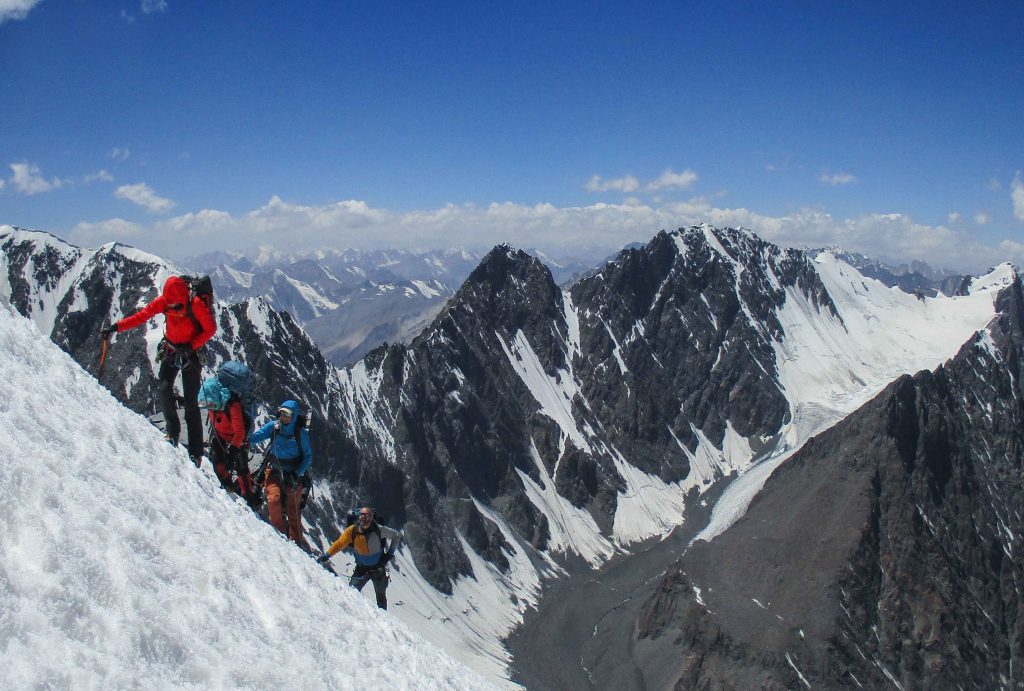 The trip (time in the mountains) was approximately 25 days; we summited on the last possible day our schedule allowed.
The trip (time in the mountains) was approximately 25 days; we summited on the last possible day our schedule allowed.
To get to the mountain we first had to fly via private charter (6-seater, fixed wing) from Kabul to the northern border town of Ishkashim (it’s far too dangerous to drive although our bags and gear were sent via truck which took 3 days). It was an incredible two-hour flight with views of endless unclimbed peaks in the Hindu Kush. From Ishkashim we drove 45 minutes to the village of Qazi-deh and started walking from there. The approach to basecamp took 4 days and was approximately 40km; we started at 8000′ and basecamp was at 15500′. The walk in was entirely on dirt, rock, and scree along a silty glacial river. It was very dry and dusty, and we didn’t touch snow until we started climbing up the actual mountain at about 16000′. Basecamp was a perfect flat spot on rocky glacial moraine; there was only a tiny spring for water and it often dried up in the afternoon. Water stress was pretty real.
The standard route up Noshaq from the Afghan side (the summit ridgeline is shared with Pakistan and another less used route ascends via the Pakistan side), climbs the broad, northwest ridge. The mountain itself was rapidly melting and changed a lot by the time we left. Initially we were able to climb to camp 1 (18,200′) on steep snow and ice. By the time we descended after the summit, camp 1 to basecamp was all loose rock and scree (which is arguably worse than low angle water ice). Above C1 the climbing was snow and ice slopes up to 50-degrees and pretty straightforward with only small, avoidable crevasses. I did lots of short roping but there were also plenty of times where we just walked uphill/downhill unroped. If this peak were in the Himalayas, I suspect it would be covered in fixed rope. There was a 100m section of more technical climbing and fixed lines at about 6800m.
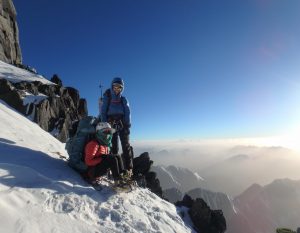 We had very stable weather. Noshaq manages to stay just north of the monsoonal flow so other than a couple days of mildly stormy weather, we had endless blue skies, calm winds, and relatively mild temps (maybe -20F at night at 7000m and about 20F during the day at 7000m).
We had very stable weather. Noshaq manages to stay just north of the monsoonal flow so other than a couple days of mildly stormy weather, we had endless blue skies, calm winds, and relatively mild temps (maybe -20F at night at 7000m and about 20F during the day at 7000m).
The altitude affected everyone a little differently though all in all, everyone did well. Hanifa did get altitude sick enough (pulse ox 49 and vomiting) at C2 (20,500′) that we descended to C1 for a couple of days where, surprisingly, she recovered enough to go back up. As a side note, we had one cylinder of emergency oxygen in BC, but we weren’t climbing with or on oxygen. As another side note, I’m not a high-altitude climber. I’m pretty decent at just suffering out the discomfort but I did lose 25lbs! Which I think is a bit of an indication that I wasn’t actually acclimatizing well. Otherwise, the rest of the team did well, and we did our best to balance acclimatization with not being too high for too long.
Angela: What was the hardest part of the expedition for you and what was your greatest reward?
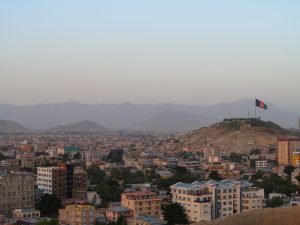 Emilie: The greatest reward was that we succeeded in getting an Afghan woman to the top of her country’s highest peak against ALL odds. And of course, we had no issues with significant injury, illness, kidnapping, Taliban, or ISIS, so that’s pretty rewarding.
Emilie: The greatest reward was that we succeeded in getting an Afghan woman to the top of her country’s highest peak against ALL odds. And of course, we had no issues with significant injury, illness, kidnapping, Taliban, or ISIS, so that’s pretty rewarding.
That said, nothing leading up to this expedition was stacked in our favor: the expedition was almost cancelled after Dave, Danika, and Dr. May (who would have been our BC doctor) all left the expedition on very short notice. We made some tough decisions and decided to go ahead and attempt the mountain without them anyway. Then there was intense Taliban fighting only 20km south of Ishkashim, where our expedition was to start. An American friend/acquaintance (Doug Chabot) who was in the area for work, reached out to let me know that people were evacuating Ishkashim for fear that it would be the next town taken by the Taliban as they worked their way toward the Tajikistan border. He also said that the Taliban values American’s at 7 million dollars and that knowing my worth should help in making the go or no-go decision. Luckily the Afghan government regained control, but our chartered aircraft wouldn’t fly over the conflicted area because small planes that don’t fly much above 15k get shot down all the time. We delayed for a few days and then they agreed to fly but rerouted us to an area much deeper in the Wakhan closer to the Chinese border. This meant an epic (and I think that word is heavily overused!) 13-hour drive back toward Ishkashim.
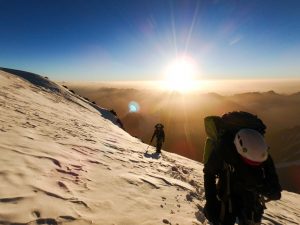 Things smoothed out once we reached BC and started making some attempts to acclimatize and reach Camp 1. At this point it became obvious that most of the girls seriously lacked the skills and fitness to be climbing an icy, semi-technical 7500m peak. As this became more and more obvious, the trip started to become not only the hardest part of the expedition, but one of the hardest, most dangerous things I’ve ever done. While Noshaq is considered ‘easy’ for a 7500m peak, the second you tie yourself to one or two inexperienced climbers (the girls had been on crampons for only one hour ever on a previous training trip) via short rope on 50-degree slopes of water ice disguised as snow, it all becomes quite real. While we had porters (donkeys) to help carry loads to basecamp, we didn’t have high-altitude porters or any other kind of climbing support (no such thing exists in this part of the world). So, in addition to encountering steep, icy terrain, we also had huge, heavy Denali-esque packs. The number of times I thought to myself, ‘I wonder how long of a sliding fall I can survive if I get pulled off my feet’, was countless.
Things smoothed out once we reached BC and started making some attempts to acclimatize and reach Camp 1. At this point it became obvious that most of the girls seriously lacked the skills and fitness to be climbing an icy, semi-technical 7500m peak. As this became more and more obvious, the trip started to become not only the hardest part of the expedition, but one of the hardest, most dangerous things I’ve ever done. While Noshaq is considered ‘easy’ for a 7500m peak, the second you tie yourself to one or two inexperienced climbers (the girls had been on crampons for only one hour ever on a previous training trip) via short rope on 50-degree slopes of water ice disguised as snow, it all becomes quite real. While we had porters (donkeys) to help carry loads to basecamp, we didn’t have high-altitude porters or any other kind of climbing support (no such thing exists in this part of the world). So, in addition to encountering steep, icy terrain, we also had huge, heavy Denali-esque packs. The number of times I thought to myself, ‘I wonder how long of a sliding fall I can survive if I get pulled off my feet’, was countless.
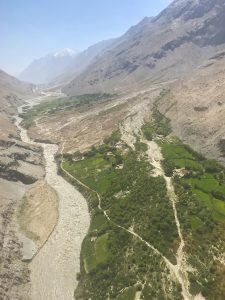 Angela: What do you think are the biggest take-a-ways for these women after such a success?
Angela: What do you think are the biggest take-a-ways for these women after such a success?
Emilie: I hope (and think) that one of their biggest take-a-ways is that you don’t just get to climb a mountain because you show up and expect it to happen – there’s much more involved. I think the girls learned that giving up a dream (at least temporarily) so that one team member has a chance at the summit is both a type of teamwork and something that requires leadership to execute successfully. To be clear, when we had to tell them that only one of them really had the ability to attempt the summit, the others were understandably devastated. Initially they were angry and said they never would have even gone to BC just to be told they couldn’t climb; they thought the trip was useless and now they would have to go home and tell their families that they were ‘failures’.
However, over time I think all the girls learned that something hard, whether it’s mountain climbing, speaking English, or being away from family is made easier and more successful with the help of a supportive team or group of people. And that change does happen, but it happens when a group of like-minded people come together to work toward a common goal.
Angela: Does Ascend have future goals for these women and expanding it’s reach in Afghanistan or neighboring countries?
Emilie: For security reasons, objectives, plans, and locations are never made public. Only after an expedition is there any announcement or media coverage.
Emilie Drinkwater is an American Mountain Guide/IFMGA and has been guiding since 2001 and has been instructing for the AMGA National Instructor Team since 2016. She instructs introductory level rock, alpine, and ski programs for the AMGA. Emilie lives in Salt Lake City, UT.
Angela Hawse is an American Mountain Guide/IFMGA and is teh Vice President of the AMGA Board of Directors. She has been guiding since 1985 and has been instructing for the AMGA National Instructor Team since 2005. She instructs and examines rock, alpine, and ice programs for the AMGA. Angela lives in Ridgeway, CO.


